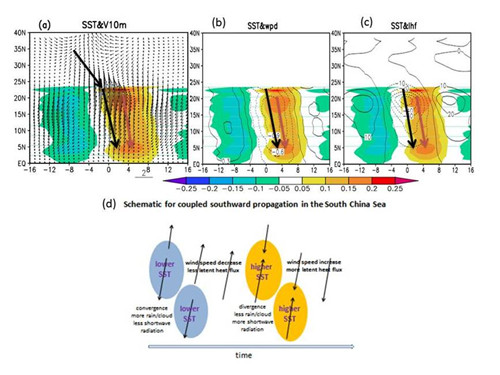
Intraseasonal variation is an important component of climate variability over the South China Sea and the tropical western Pacific region. There is indication for a coupled intraseasonal variation in sea surface temperature (SST) and atmosphere in the tropical Indo-western Pacific region. Yet, previous studies are mostly concerned with intraseasonal variations during boreal summer with less being about intraseasonal variations in the South China Sea and western North Pacific region during boreal winter.
Analysis of Prof. WU Renguang from the Institute of Atmospheric Physics of the Chinese Academy of Sciences showed that SST in the South China Sea displays prominent intraseasonal variations during boreal winter with a spectrum peak in the 10-30-day time period.
These intraseasonal SST variations are closely associated with intraseasonal variations of the East Asian winter monsoon (EAWM). A weak EAWM is preceded by cooler SST and followed by warmer SST in the South China Sea and subtropical western North Pacific.
His study reveals a coherent southward propagation in the South China Sea in SST, surface wind, and latent heat flux anomalies. This southward propagation is attributed to the wind-evaporation-SST effect under climatological northerly winds in winter, which differs from summer when climatological winds are westerly.
The SST-induced wind speed anomalies are larger to the north side of SST anomalies. This induces larger surface evaporation anomalies to the north side, leading to a southward displacement of large SST anomalies.
In turn, wind and evaporation anomalies move southward. There appears to be a positive feedback between circulation and precipitation that leads to amplification of meridional wind anomalies when the SST anomalies are weak.

Figure 1 Hovemöller diagrams of anomalies along 107.5°-120°E of SST (ºC, shading) and 10 m wind (m/s, scale at bottom) (a), surface wind speed (interval: 0.3 m/s) (b), and surface latent heat flux (interval: 10 W/m2) (c) from 16 days before to 16 days after the EAWMI obtained by regression with respect to the normalized EAWMI defined using area-mean meridional wind at 10 m averaged over the region of 10°-25°N and 105°-135°E. (d) A schematic for the coupled southward propagation of 10-30-day intraseasonal anomalies in the South China Sea. (Image by Wu)
His analysis shows that surface latent heat flux is a dominant factor for the SST change in the South China Sea and the Yellow Sea. Shortwave radiation has a complementary contribution to the SST change in the South China Sea, but has a negative effect in the Yellow Sea. The wind-induced Ekman advection appears important for the SST warming in the Yellow Sea.
The results entiled Coupled intraseasonal variations in the East Asian winter monsoon and the South China Sea–western North Pacific SST in boreal winter were published on Springer Link.

86-10-68597521 (day)
86-10-68597289 (night)

86-10-68511095 (day)
86-10-68512458 (night)

cas_en@cas.cn

52 Sanlihe Rd., Xicheng District,
Beijing, China (100864)

